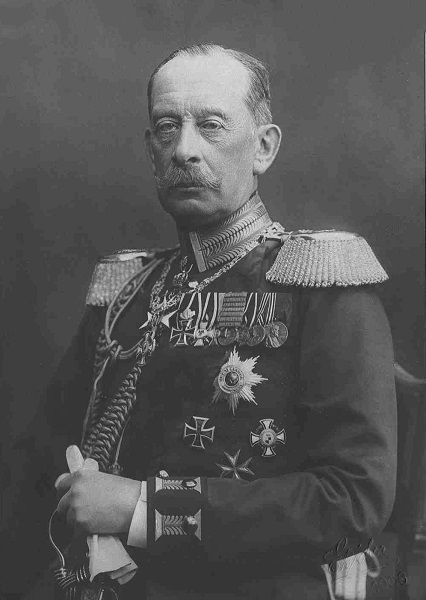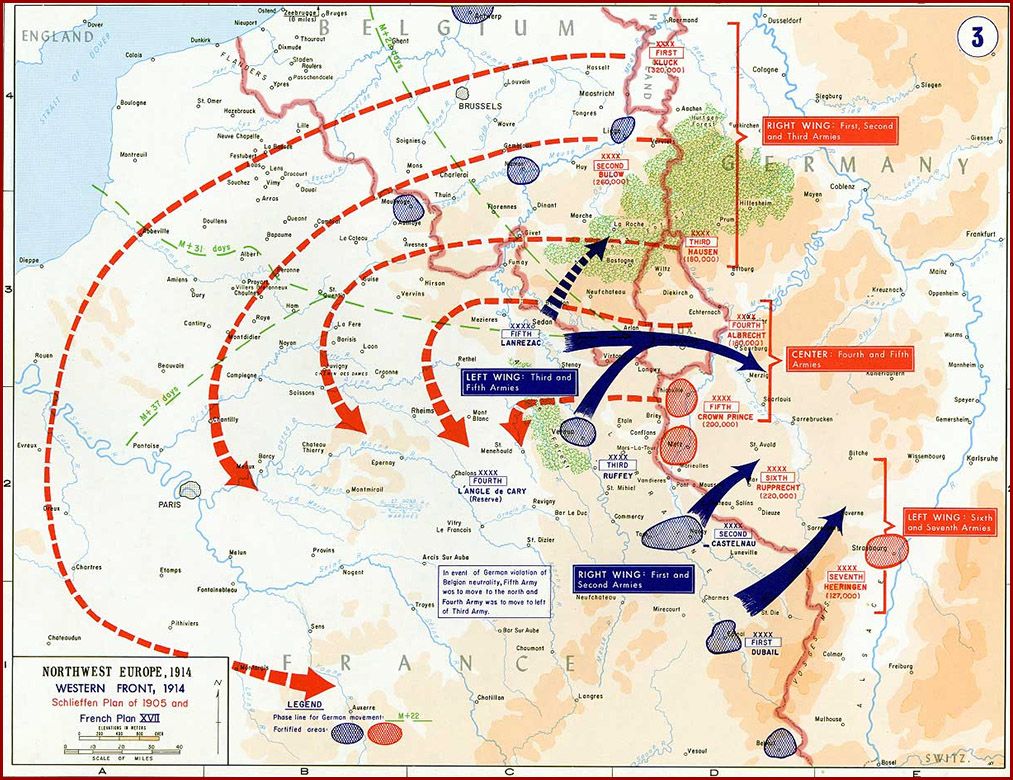● ● ●
In
August 1914 those icons of the Great War—the trenches, the barbed-wire
entanglements, no man's land, the ingredients of the congealed stalemate
to come—did not yet exist. The war began as a
war of maneuver, and the battles of its first few months
were
decisive for the next four years.
In the west it
was the so-called Schlieffen Plan—or rather its failure—that
produced stalemate. Field Marshal Count Alfred von Schlieffen, the
Chief of the Great General Staff from 1891 to 1906, grappled for
fifteen years with the military dimensions of a problem that had
long preoccupied Germany’s leaders: the dread prospect of a
two-front war. To the west of the Reich lay France, nurturing bitter
memories of the humiliation of 1871, meditating upon revenge. To the
east loomed Russia, smarting from past slights, maturing vast
ambitions. In earlier times Bismarck’s diplomatic sleight-of-hand had
prevented the iron ring from closing around Germany, his policy
being
to keep France isolated by preventing a Franco-Russian alliance.
This meant staying on friendly terms with the eastern colossus
despite the tensions between Germany’s ally, Austria-Hungary, and
Russia over Balkan issues. But after Bismarck’s retirement his
policy was abandoned—and a Franco-Russian alliance duly followed.
Diplomacy thus
having failed, military solutions were substituted. These took the
form of a number of deployment (Aufmarsch) plans, each
specific to some particular contingency. For example, Aufmarsch I
West was Schlieffen’s deployment plan for a war between Germany
and France with Russia remaining neutral. It envisioned an offensive
with the bulk of the German Army massed on the right, moving into
Belgium and the southern Netherlands, down the Channel coast,
crossing the Somme and Seine rivers, wheeling north and south of
Paris. The enemy’s left flank was to be crushed in a series of
encounter battles, culminating in the annihilation of the French
Army.
The march
through Belgium was deemed necessary because only in that way could
the full strength of the German Army be brought to bear. Along the
common frontier the space needed for such a deployment was not
available. Between Belgium and Switzerland the French had
constructed a number of strongly fortified positions, so sited as to
“canalize” any German offensive, narrowing its front and rendering
it vulnerable to counterattack. Schlieffen proposed to hold this
sector with minimal forces. He reasoned that a French offensive
across the common border would actually facilitate Aufmarsch I West in
the manner of a revolving door: The harder the French pushed against
the German left wing, the more surely and swiftly the German right wing
would descend on their rear. Even so, Schlieffen was dubious about
the prospects for success by offensive action. He noted that the
German Army was really too small (79 divisions in 1914) to carry out
the great right-flank march; 96 divisions, he thought, was the
minimum requirement, and for various reasons this appeared
impossible. The Reichstag would not give the necessary money,
while the naval program so favored by Kaiser William II competed
with the army for available funds.

Field Marshal Alfred Graf von Schlieffen, Chief of the Great
General Staff, 1891-1906 (Bundesarchiv)
But
Aufmarsch I West was only one of four deployment plans available
to the German Army and the situation on which it was
predicated—Russian neutrality in a Franco-German war—was considered
to be the least likely. General Helmuth von Moltke, nephew of the great
Moltke, who replaced Schlieffen as Chief of Staff in 1906, at first favored Aufmarsch
II West, the plan for a war pitting Germany and Austria-Hungary
against France and Russia. It was assumed in that case that both
France and Russia would launch offensives after their mobilizations
were complete. Aufmarsch II West allotted four-fifths of the
Army against France and one-fifth against Russia. In the east, the
German and Austro-Hungarian armies would initially stand on the
defensive. In the west the Germans would mass their forces against
the attacking French, first checking the enemy's offensive, then launching a
counteroffensive. After its successful conclusion, about a quarter
of the Army in the west would go east to join the Austrians in a
counteroffensive against the Russians.
Aufmarsch
II West was based on Ermattungsstrategie: the “strategy
of exhaustion.” Moltke and his General Staff colleagues had come to
doubt that the alternative, Vernichtungsstrategie, the
“strategy of annihilation,” was feasible in the age of mass armies.
But by standing on the strategic defensive and winning battles on
the tactical offensive, Germany might hope to create a diplomatic
situation leading to a negotiated peace on favorable terms. In 1906,
with the Russian Army in a shambles after its drubbing in the
Russo-Japanese War and the country itself reeling from the shock of
the 1905 revolution, this strategy seemed to be Germany’s best
military option. Owing to Russia’s size, sparse rail net,
administrative inefficiency and social instability, mobilization
required at least two months: about twice as long as German and
French mobilization. There would be ample time, therefore, for
Germany to win the defensive battle against France in the west, and then
to redeploy forces to the east against Russia. Moltke also counted
on the German Army’s qualitative superiority for success on the
battlefield.
But with the
passage of time the assumptions underlying Aufmarsch II West
seemed more and more dubious. Russia and the Russian Army recovered
much more quickly than expected from the ravages of war and
revolution. An economic boom provided the industrial base and
financial resources for large new military and naval programs, while
French loans underwrote a major expansion of the rail net. Watching
all this with alarm from Berlin, Moltke and the General Staff saw
their margins of time and military superiority ebbing away. They
reacted with a decision that was to determine the course not only of
the coming war but of twentieth-century history.
Fearful that
the strategy of exhaustion would commit Germany to a long,
eventually losing, war of attrition, Moltke turned again to the
strategy of annihilation. Aufmarsch II West was modified to
embody the strategic offensive that Schlieffen had drawn up for a
war between Germany and France only: the Aufmarsch I West
right wheel through Belgium, aiming at the destruction of the French
Army. The Chief of Staff believed that Russian mobilization,
improved though it was, would still take more time than that of the
other powers. Here, then, was Germany’s opportunity. If the French
Army could be destroyed before the Russian Army was ready to march,
the encirclement of the Reich would be broken. With France
prostrate, Russia could then be dealt with at leisure and would
probably opt for a compromise peace.
The German
deployment plan of August 1914 was, therefore, a hybrid scheme. The
balance of German forces between east and west was about equal to
that of Aufmarsch II West but the plan of operations
envisioned offensives in both theaters of war. In the east
the main burden of offensive action would fall initially on the
Austro-Hungarian Army, attacking into Russia from Galicia, this to
relieve pressure on the small German force defending East Prussia.
After France had been defeated a large part of the German Army in
the western theater would go east to join in the offensive against
Russia.
Moltke also
made some important tactical alterations to Schlieffen’s original
plan for the offensive against France. Whereas the latter had called
for maximum strength on the right and was willing to yield ground on
the left, Moltke worried about a French breakthrough in Lorraine. He
therefore took forces from the armies of the right wing, allotting
them to the left wing. Schlieffen had planned for the right wing to
pass through the southern tongue of Dutch territory; Moltke decided
that it would be better to preserve the neutrality of the
Netherlands. The result was that the front of the German right wing
was somewhat constricted in the first phase of the campaign.
Thus the
famous Schlieffen Plan was not, as many believe to this day, the
brainchild of one man, imposing his will on the future. Though the
German deployment scheme of 1914 was largely based on Schlieffen’s
work it also reflected the thinking—and the fears—of his successor.
And as the day of battle approached, no man could predict the
consequences that would flow from Germany's decision to seek victory
through Vernichtungsstrategie.


